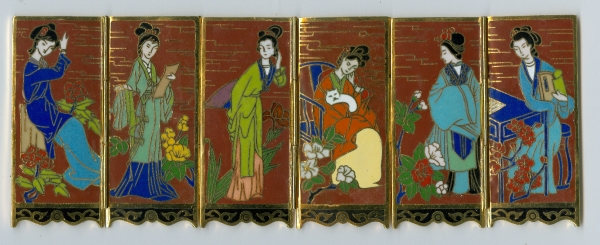Summary: with new pricing and display policies, the US Goodwill charity risks alienating the very collectors and upcycler artists it has been using to gentrify its brand identity.
When I was a kid, thrift stores were forbidden territory. My mother had a not-unfounded horror of thrift stores as vectors of disease and infestation*. She also displayed the Depression-Era survivor’s practical mantra of ‘We can make it if we can’t afford to buy it, but when we can afford it, we are damn well buying it NEW.’
So I didn’t start seriously thrifting until several things came together in my life: a car, college, a little spending money, the Society for Creative Anachronism, and my growing fiber art skills.
While my mom made certain I knew how to sew a garment from a pattern, I am a profoundly lazy person and only do that when I must. I simply like handwork embellishment more than structural sewing. Good quality thrift garments provide a foundation for that work.

Once I started doing fiber book art sculptures and beaded jewelry, my thrift adventures became capital investment opportunities. I look for interesting fabric, wood pieces, leather goods, art supplies, and finished clothing.

This denim tailcoat was originally a Bamboo Traders jacket and a Carole Little circle skirt with a 100-inch hem. I had been set to buy denim yardage when I realized the skirt *was already halfway to becoming a tailcoat ruffle*. Since the skirt was $3.49, it was an easy call.
Thrift store jewelry and bric-a-brac has been a big part of my fiber art, as well. I have to be careful to avoid cadmium pieces dumped by Chinese companies, but glass, wood, and gemstone beads are always a useful find.

Until now.
Many Goodwill stores have stopped putting jewelry, high-end clothing, and decor pieces in the stores, and have listed those online through the charity’s own online market. There, the prices are higher, the buyers have to pay shipping, and there is none of the instant thrill of treasure-hunting.
This has been a complaint for at least two decades: that the really good stuff never makes it into the brick-and-mortar Goodwill stores, but is held for Goodwill’s high-end auctions. Goodwill spokespeople have always referred back to their primary mandate to help disadvantaged people gain employment. The charity money they get from sales is supposed to help fund that goal.**
Many of the same Goodwill stores have raised their prices on the pieces that remain available. I know why. Online markets like Ebay and Poshmark exist because savvy buyers snap up thrift pieces at deep discount and resell them to people who don’t have the time, skill, or inclination to go thrifting.
The people who are really hurt by the changes at Goodwill are the generally lower-income upcycler artists like me, who do a lot of post-sale work to turn thrift store pieces into unique treasures.
Goodwill has been courting us to help gentrify and justify their stores, while at the same time shutting us out from browsing their better stock.
So, like a lot of upcyclers, I’m taking stock of my Goodwill habits. I have a large collection of what less-creative people would call junk. I also have the internet. It’s very likely I don’t need Goodwill anymore.
*She was not wrong. There is a reason why I put all thrift store finds into decontamination bags first, and expose them to a cycle of heat, freezing, then washing. I once worked for a year-and-a-half at a now-defunct resale store we line workers privately called ‘Crotch Stains of the Arizona Rich & Famous’. Oi, the things we saw while wearing gloves and face masks…
**I also worked at a Goodwill in the 2000s, and I can attest that Goodwill sometimes has a certain…predatory…attitude toward the ‘disadvantaged’ workers it supports. Not all Goodwills, and not all managers and regional directors skim huge salaries and play favorites with clients, but enough bad stories crop up to give me pause.